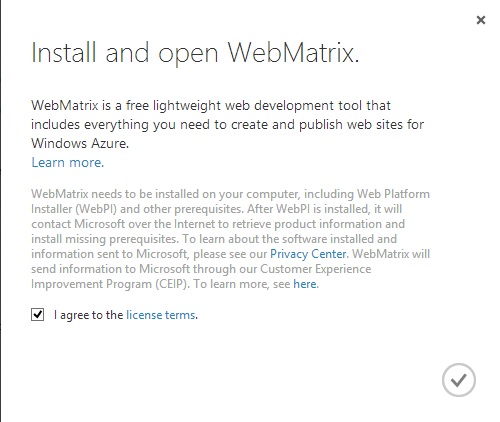Consuming an OData (Open Data Protocol) in Client devices , Client services are quite easy. Open Data protocol , is a web protocol for querying and updating data and it was born of the need to break down data silos and increase their shared value. This allows data silos to interoperate between producers such as SQL Server, SharePoint servers, Cloud Storage Services, and consumers, for example Java, PHP, Silverlight, IIS, ASP.NET, AJAX.
OData incorporates with JSON, AtomPub, RSS to provide access to the information from a range of applications, services, relational databases, file systems, content management systems (CMS), traditional websites.
Supported Platforms for OData Services:
- Microsoft Visual Studio 2008 SP1
- Microsoft Visual Studio 2010
- Microsoft SQL Server 2008 R2
- Microsoft Sharepoint 2010
- Microsoft Windows Azure Storage(Blobs, Tables, Queues)
- Microsoft SQL Azure
- Microsoft Office Excel 2010 PowerPivot
- Lets create an OData WCF REST Service that for this purpose lets create an empty web application from Visual Studio

- Lets add a new WCF Service in the application & named it as Service.SVC

- Next , add the following Code to the service & check the resulting feed in browser.
using System;
using System.Collections.Generic;
using System.Data.Services;
using System.Data.Services.Common;
using System.Linq;
using System.ServiceModel.Web;
using System.Web;
namespace ODataSample1
{
public class Service : DataService<SampleDataSource>
{
// This method is called only once to initialize service-wide policies.
public static void InitializeService(DataServiceConfiguration config)
{
// TODO: set rules to indicate which entity sets and service operations are visible, updatable, etc.
// Examples:
// config.SetEntitySetAccessRule(“MyEntityset”, EntitySetRights.AllRead);
// config.SetServiceOperationAccessRule(“MyServiceOperation”, ServiceOperationRights.All);
config.SetEntitySetAccessRule(“*”, EntitySetRights.All);
config.SetServiceOperationAccessRule(“*”, ServiceOperationRights.All);
config.MaxResultsPerCollection = 100;
config.DataServiceBehavior.MaxProtocolVersion = DataServiceProtocolVersion.V2;
}
}
[ EntityPropertyMappingAttribute(“CustomerName”, SyndicationItemProperty.Title, SyndicationTextContentKind.Plaintext, true)]
[DataServiceKey(“CustomerID”)]
public class CustomerRecord
{
public int CustomerID { get; set; }
public string CustomerName { get; set; }
public string CustomerEmail { get; set; }
public string CustomerNotes { get; set; }
public DateTime CustomerLastContact { get; set; }
}
public class SampleDataSource
{
private readonly List<CustomerRecord> _sampleCustomerRecordList;
public SampleDataSource()
{
_sampleCustomerRecordList = newList<CustomerRecord>();
for (int i = 0; i < 100; i++)
{
CustomerRecord CR = newCustomerRecord();
CR.CustomerID = i;
CR.CustomerName =string.Format(“FirstName{0} LastName{1}”, i.ToString(), i.ToString());
CR.CustomerEmail =string.Format(“Email{0}@{1}.com”, i.ToString(), i.ToString());
CR.CustomerNotes =string.Format(“Notes{0}.Notes{1}”, i.ToString(), i.ToString());
CR.CustomerLastContact =DateTime.Now.AddDays(-10000).AddHours(i);
_sampleCustomerRecordList.Add(CR);
}
}
public IQueryable<CustomerRecord> SampleCustomerData
{
get
{
return _sampleCustomerRecordList.AsQueryable();
}
}
}
}
- Now check the Service status in Linqpad (http://www.linqpad.com) by adding the WCF service endpoint to the database/service endpoint connection.

- Lets check the status of the feed by entering query (<atom:title>)(e.g : SampleCustomerData for this demo)in the browser

- Check after entering query in the URL of the feed

- Service endpoint shows successful OData feed , next add a Windows Phone Panorama Application with the solution to implement a smartClient to the OData REST application.

datasvcutil /uri:http://localhost:8554/Service.svc/ /out:.\ServiceModel.cs /Version:2.0 /DataServiceCollection

<!–Panorama item one–>
<controls:PanoramaItem Header=”first item”>
<ListBox x:Name=”lst” Margin=”0,0,-12,0″ ItemsSource=”{Binding}”>
<ListBox.ItemTemplate>
<DataTemplate>
<StackPanel Margin=”0,0,0,17″ Width=”432″>
<TextBlock Text=”{Binding CustomerID}” TextWrapping=”Wrap” Margin=”12,-6,12,0″ Style=”{StaticResource PhoneTextExtraLargeStyle}” />
<TextBlock Text=”{Binding CustomerName}” TextWrapping=”Wrap” Margin=”12,-6,12,0″ Style=”{StaticResource PhoneTextExtraLargeStyle}” />
<TextBlock Text=”{Binding CustomerEmail}” TextWrapping=”Wrap” Margin=”12,-6,12,0″ Style=”{StaticResource PhoneTextExtraLargeStyle}” />
<TextBlock Text=”{Binding CustomerNotes}” TextWrapping=”Wrap” Margin=”12,-6,12,0″ Style=”{StaticResource PhoneTextExtraLargeStyle}” />
</StackPanel>
</DataTemplate>
</ListBox.ItemTemplate>
</ListBox>
</controls:PanoramaItem>
using System;
using System.Collections.Generic;
using System.Linq;
using System.Net;
using System.Windows;
using System.Windows.Controls;
using System.Windows.Documents;
using System.Windows.Input;
using System.Windows.Media;
using System.Windows.Media.Animation;
using System.Windows.Shapes;
using Microsoft.Phone.Controls;
using ODataWP7Panorama.CustomersModel;
using System.Data.Services.Client;
namespace ODataWP7Panorama
{
public partial classMainPage : PhoneApplicationPage
{
public SampleDataSource ctx = new SampleDataSource(new Uri(“http://localhost:8554/Service.svc/”, UriKind.Absolute));
// Constructor
public MainPage()
{
InitializeComponent();
this.Loaded += newRoutedEventHandler(MainPage_Loaded);
// Set the data context of the listbox control to the sample data
}
// Load data for the ViewModel Items
private void MainPage_Loaded(object sender, RoutedEventArgs e)
{
var ctx = newSampleDataSource(newUri(http://localhost:8554/Service.svc/));
var coll = new DataServiceCollection<CustomerRecord>(ctx);
lst.ItemsSource = coll;
coll.LoadCompleted +=newEventHandler<LoadCompletedEventArgs>(coll_LoadCompleted);
var qry = “/SampleCustomerData”;
coll.LoadAsync(newUri(qry, UriKind.Relative));
}
void coll_LoadCompleted(object sender, LoadCompletedEventArgs e)
{
if (e.Error != null)
{
MessageBox.Show(e.Error.Message);
}
}
}
}
- Now , lets the OData REST Service in Windows Phone 7.1 Client :




















You must be logged in to post a comment.